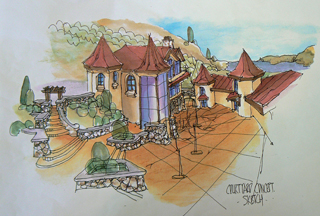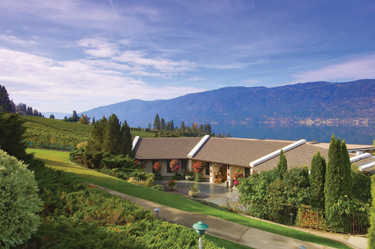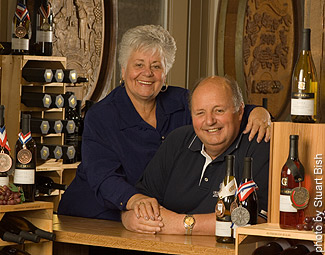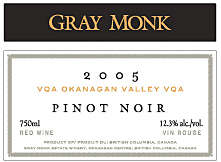

Continued major business growth at Gray Monk Cellars has compelled a building renovation for which a draft design is seen here.
Gray Monk Estate –
Winery as Terroir
When Gray Monk’s renovation is complete in 2009, the baroque styling will turn the winery into a north Okanagan showpiece. Overlooking Okanagan Lake, will this be an example of winery as terroir?
by
John Schreiner
August 16, 2007
A majestic $2-million winery facelift, set to start this Fall at the Gray Monk Estate Winery near Kelowna, should cement the legacy of the Heiss family as a cornerstone of the modern British Columbia wine industry.
This is one of the first examples in Canada of a family who are now bringing a fourth generation into the wine business. This would be unremarkable in Europe but in a wine region as young as British Columbia, it signifies that winegrowing has taken root.
When Gray Monk’s renovation is complete in 2009, the baroque styling will turn the winery into a north Okanagan showpiece.

Gray Monk Before – Overlooking Okanagan Lake, Gray Monk Cellars’s current building will be completely renovated.
[Photo by Brian Sprout]The original winery, opened in 1982, is a long, low, banana-shaped structure set into a steep slope, with below-ground cellars. The winery and the surrounding vineyard share a south-western aspect overlooking Okanagan Lake that benefits viticulture and provides tourists with picture-postcard views from the tasting room and winery restaurant.
The practical reason for the renovation is that Gray Monk’s growth has outpaced the winery’s footprint, even after two expansions in the 1990s and the erection of a massive off-site warehouse and barrel cellar in 2004. The current wine shop, at 800 square feet, is so jammed that at times consumers abandon potential purchases in the long checkout line. The proposed new wine shop will be 2,000 square feet.
But there is more than extra elbow room to justify the elaborate facelift. The triumphal design transforms the winery into a two-tower structure with gabled windows. It would be not be out of place in Bernkastel, the historic wine town on the Mosel.
The design celebrates the Heiss family’s accomplishments in British Columbia wine and makes the statement that the family is here for the long haul.
The first generation of the family to enter the industry was Hugo Peter, George Sr.’s father-in-law. In 1968, when there were just five wineries in British Columbia (compared with 135 today), Peter converted an orchard into a vineyard.
Four years later, the second generation joined him when his daughter Trudy and son-in-law George Sr., who had operated hair salons, planted a vineyard next door to Peter on the site that became the Gray Monk winery and vineyard.
At the time, British Columbia’s vineyards grew French hybrid or labrusca vines almost exclusively. Peter and the Heisses were novice grape growers but, having grown up in Germany and Austria, they knew vinifera vines were needed to grow world-class wines. That understanding helped lay the foundation for quality wines in British Columbia.
In 1976, they imported several important white vinifera vines directly from Alsace, including the first Pinot Gris planted in the Okanagan (likely the first in Canada). The variety,
Trudy and George Heiss.currently surging in popularity as far afield as New Zealand, California and Italy, now is British Columbia’s second most-planted white variety, at 563 acres. Within a few years, it is expected to pass Chardonnay, becoming British Columbia’s number one white.
At the same time, the Heisses planted the Okanagan’s first Pinot Auxerrois, Kerner and Alsace clones of Gewürztraminer. They pioneered Ehrenfelser, after, as they once put it, being “tipped off” to the variety’s potential by the late Dr. Helmut Becker, the renowned director of viticulture at Germany’s Geisenheim Institute.
Becker toured the Okanagan in 1975 for the first time. Struck by the Heiss family’s intention to grow vinifera, he offered them about 30 varieties from Geisenheim for evaluation in the Heiss vineyards.
Heiss and Peter levered this offer into industry-backed trials, with several Okanagan test plots. The results of these trials, which ended in 1985, proved the general viability of vinifera for the Okanagan, including varieties such as Pinot Blanc and Riesling, now widely grown there.
The third generation of the Heiss family to join the business was George and Trudy’s son, George Jr. After training in a German wine school, he took over as Gray Monk’s winemaker in 1984, soon after the winery opened. Subsequently, he also took over the Peter vineyard.
 The Heiss vineyards gave George Jr. a significant advantage. He was making wines with vinifera grapes when many of his peers still struggled with hybrids. Until competitors switched to vinifera as well, Gray Monk dominated wine competitions in the 1980s and established its enviable reputation for full-flavoured white wines.
The Heiss vineyards gave George Jr. a significant advantage. He was making wines with vinifera grapes when many of his peers still struggled with hybrids. Until competitors switched to vinifera as well, Gray Monk dominated wine competitions in the 1980s and established its enviable reputation for full-flavoured white wines.
The third generation also includes George Jr.’s younger brother, Steven, who joined Gray Monk in 1994, both in sales and as a grape grower; and his older brother, Robert, a former meteorologist, who moved into winery operations in 2004. The fourth generation is represented by Robert’s son, Keiran, who is just starting studies in viticulture.
Gray Monk now has an annual production of 70,000 cases, with fruit from 50 acres of family-owned vineyards and from growers throughout the Okanagan, all of which display large signs identifying them as “proud” Gray Monk growers. Pinot Gris remains the signature variety, comprising about 9000 cases.
Get a taste of Gray Monk wines. Read John Schreiner’s reviews of the Okanagan Valley winery’s latest releases.
This is one of the first examples in Canada of a family who are now bringing a fourth generation into the wine business. This would be unremarkable in Europe but in a wine region as young as British Columbia, it signifies that winegrowing has taken root.
When Gray Monk’s renovation is complete in 2009, the baroque styling will turn the winery into a north Okanagan showpiece.

Gray Monk Before – Overlooking Okanagan Lake, Gray Monk Cellars’s current building will be completely renovated.
[Photo by Brian Sprout]
The practical reason for the renovation is that Gray Monk’s growth has outpaced the winery’s footprint, even after two expansions in the 1990s and the erection of a massive off-site warehouse and barrel cellar in 2004. The current wine shop, at 800 square feet, is so jammed that at times consumers abandon potential purchases in the long checkout line. The proposed new wine shop will be 2,000 square feet.
But there is more than extra elbow room to justify the elaborate facelift. The triumphal design transforms the winery into a two-tower structure with gabled windows. It would be not be out of place in Bernkastel, the historic wine town on the Mosel.
The design celebrates the Heiss family’s accomplishments in British Columbia wine and makes the statement that the family is here for the long haul.
The first generation of the family to enter the industry was Hugo Peter, George Sr.’s father-in-law. In 1968, when there were just five wineries in British Columbia (compared with 135 today), Peter converted an orchard into a vineyard.
Four years later, the second generation joined him when his daughter Trudy and son-in-law George Sr., who had operated hair salons, planted a vineyard next door to Peter on the site that became the Gray Monk winery and vineyard.
At the time, British Columbia’s vineyards grew French hybrid or labrusca vines almost exclusively. Peter and the Heisses were novice grape growers but, having grown up in Germany and Austria, they knew vinifera vines were needed to grow world-class wines. That understanding helped lay the foundation for quality wines in British Columbia.
In 1976, they imported several important white vinifera vines directly from Alsace, including the first Pinot Gris planted in the Okanagan (likely the first in Canada). The variety,

Trudy and George Heiss.
At the same time, the Heisses planted the Okanagan’s first Pinot Auxerrois, Kerner and Alsace clones of Gewürztraminer. They pioneered Ehrenfelser, after, as they once put it, being “tipped off” to the variety’s potential by the late Dr. Helmut Becker, the renowned director of viticulture at Germany’s Geisenheim Institute.
Becker toured the Okanagan in 1975 for the first time. Struck by the Heiss family’s intention to grow vinifera, he offered them about 30 varieties from Geisenheim for evaluation in the Heiss vineyards.
Heiss and Peter levered this offer into industry-backed trials, with several Okanagan test plots. The results of these trials, which ended in 1985, proved the general viability of vinifera for the Okanagan, including varieties such as Pinot Blanc and Riesling, now widely grown there.
The third generation of the Heiss family to join the business was George and Trudy’s son, George Jr. After training in a German wine school, he took over as Gray Monk’s winemaker in 1984, soon after the winery opened. Subsequently, he also took over the Peter vineyard.
 The Heiss vineyards gave George Jr. a significant advantage. He was making wines with vinifera grapes when many of his peers still struggled with hybrids. Until competitors switched to vinifera as well, Gray Monk dominated wine competitions in the 1980s and established its enviable reputation for full-flavoured white wines.
The Heiss vineyards gave George Jr. a significant advantage. He was making wines with vinifera grapes when many of his peers still struggled with hybrids. Until competitors switched to vinifera as well, Gray Monk dominated wine competitions in the 1980s and established its enviable reputation for full-flavoured white wines.
The third generation also includes George Jr.’s younger brother, Steven, who joined Gray Monk in 1994, both in sales and as a grape grower; and his older brother, Robert, a former meteorologist, who moved into winery operations in 2004. The fourth generation is represented by Robert’s son, Keiran, who is just starting studies in viticulture.
Gray Monk now has an annual production of 70,000 cases, with fruit from 50 acres of family-owned vineyards and from growers throughout the Okanagan, all of which display large signs identifying them as “proud” Gray Monk growers. Pinot Gris remains the signature variety, comprising about 9000 cases.










 READER FEEDBACK: To post your comments on this story,
READER FEEDBACK: To post your comments on this story,


